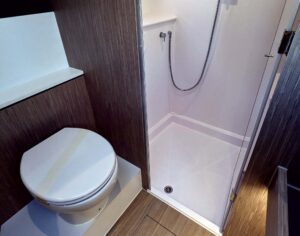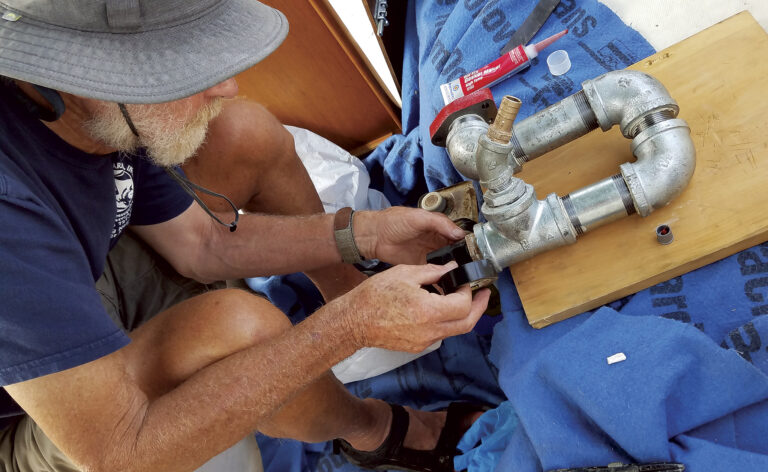Do the lead acid batteries on your boat last at least five years and preferably 10? Very few do, but they should. Although rarely recognized as such, battery failures are the most common electrical system failure on boats. These battery failures are an indication there is something wrong with the design of the system, or with the battery installation, or most likely both.
Quality batteries are expensive. On many cruising boats, a replacement house battery bank costs thousands of dollars. A ton of money is being spent on avoidable failures. Let’s explore ways to extend battery life and reduce the financial pain.
Absorption and Float
I should probably start with a whole boat electrical system design review, but that’s too ambitious a project for a magazine article. Instead, I’m going to dive into absorption and float voltages. If you’re not sure what these are, it’s time to find out.
To put charging current into a battery you must raise the battery voltage above whatever the voltage happens to be before charging commences. While charging, the voltage difference is the pressure that drives the charging current into the battery.
When a battery that is somewhere between partially discharged and deeply discharged is first put on charge, you will see its voltage rise. At some point the voltage stabilizes and flatlines for an extended period of time. This is the absorption voltage. And then at some other later point, pretty much any modern charging device (with the exception of automotive-style alternators that have internal voltage regulators) will “decide” the battery is fully charged and will trip to a voltage below the absorption voltage. This is the float voltage.
We need to accurately measure both of these voltages.
Measuring Battery Voltages
The only meaningful place to measure absorption and float voltages is at the battery posts. You likely have a voltmeter or systems monitor installed in your boat’s DC electrical panel. If this is not wired back to the battery posts (and it likely is not) it is not necessarily accurate enough for our purposes. In this case, you need a digital multimeter, and preferably one that costs more than $20.

To test the absorption and float voltages, the battery is first partially discharged. The multimeter is placed in its DC volts mode with the red meter lead/probe on the battery’s positive post, and the black on the negative. Before charging commences, a 12v battery will have a voltage somewhere below 12.8v (a 24v battery is double this, and a 48v battery quadruple this). When charging commences, the voltage will climb. If it does not, the charging device is not working.
When the voltage stops climbing, we are at the absorption voltage. Depending on the size of a battery or battery bank, its state of charge, and the output of the charging device, this can take anywhere from a few minutes to several hours. If the charging device has a float setting, depending on a variety of additional factors, the time to float can once again take anywhere from an additional few minutes to several hours.
These tests should be conducted individually for every charging device on the boat, and for every battery or battery bank on the boat. This inevitably takes some time, especially on boats with multiple battery banks and multiple charging devices, but nevertheless should not be neglected: Correct absorption and float voltages are the two most important voltages for the health of pretty much any DC system.
Multimeters
For those not used to using multimeters, the only essential function is a voltmeter. You can do most troubleshooting, with the benefit that it is hard to hurt yourself, the boat, or the meter. With some other meter functions this is not the case.
To ensure the meter has built-in protection features, it needs to be labeled, at a minimum, CAT II, along with one or more of the following: UL, CE, and/or CSA. This means it has been tested by a recognized laboratory to ensure compliance with a particular safety standard. Cat III and Cat IV provide higher levels of safety; these meters tend to be expensive.
Many meters combine DC and AC volt measurement in a single switch position with a button to toggle between DC and AC. It is easy to accidentally put the meter in the wrong mode and to get readings that make no sense. I like a meter with separate switch positions for DC and AC so there is no confusion.
Ideal Voltages
What is correct? Different types of lead acid batteries—e.g., flooded (“wet cell’), gelcell, and absorbed glass mat (AGM)—have different recommended absorption and float voltages. You must check with the battery manufacturer to find out what is appropriate. If either of these voltages is found to be off by more than a tenth or two of a volt, battery life will be impaired, and you need to find a way to correct the voltage. It may be possible to do this with voltage regulator adjustments, but if not, it will require review of the overall system design.
If a boat is plugged into shorepower at dockside, or during a layup, you need to pay particular attention to the battery charger float voltage. Over time, a float voltage just a few tenths of a volt too high will destroy batteries, especially sealed batteries (gelcells and AGMs). In addition to the damage being done to the battery, there is a risk the battery will become hot enough to start a fire. Pantaenius, a major European boat insurer, lists this as one of the principal causes of boat fire claims.
As noted, automotive-style, internally regulated alternators commonly do not trip to a float voltage. This is not a problem on most sailboats because engine use tends to be intermittent. It may become an issue on powerboats if the engines are run for long hours with the alternators charging into fully charged batteries, especially if the batteries are in the engine room—a hot ambient environment.
Thermal Runaway
Heat in general is a problem. Published battery life numbers assume a 77˚F (25˚C) ambient temperature. For every 17˚F (10˚C) increase in the ambient temperature, battery life expectancy is more or less cut in half. For long life, batteries should be installed in the coolest possible spaces on our boats. Note that a fully charged lead acid battery will never freeze even during a winter layup with temperatures as low as -40˚F (-40˚C). However, it will freeze and burst at these temperatures if allowed to discharge.
On many boats we are driving batteries way harder than we ever did in the past, notably on the discharge side with air conditioning powered by DC-to-AC inverters and with any form of electric propulsion, and on the recharge side with the latest generation of super high output alternators. A flooded lead acid battery is only around 60% efficient at converting chemical energy into electrical energy. The other 40% of charging energy produces heat during discharges or recharges, primarily recharges. Gelcells are around 75% efficient and AGMs 85%, so less heat is generated but still a fair bit. Lithium-ion are about 95% efficient, so a lot less heat, but nevertheless still enough to be a problem in many installations.
When a lead acid battery under charge heats up, its charge acceptance rate–the amount of charging current it can absorb at a given voltage–increases. The increase in charging current causes a further rise in temperature, which triggers an additional increase in the charge acceptance rate even if the battery is fully charged. We enter a vicious circle in which a fully charged battery drives charging devices to full output with the heat rising ever more rapidly and the battery boiling like a tea kettle, venting hydrogen. This is known as thermal runaway.

There’s a popular misconception that sealed batteries cannot be driven into thermal runaway and will not vent hydrogen. All lead acid batteries, regardless of type, can be driven into thermal runaway and all generate hydrogen in the final stages of charging. Flooded batteries always vent the hydrogen directly to the atmosphere. Sealed batteries have spring-loaded vents which typically contain the hydrogen, but not always. They will, on occasion, vent hydrogen.
The heat generated during thermal runaway is high enough to melt battery cases, and in extreme cases a spark, internal or external, results in a hydrogen explosion.
Controlling Heat
The fix for this is simple. If the battery temperature rises during charging, we need to back off on the charge rate by reducing the charging voltage. To enable this function, we need temperature sensing at the batteries. More and more battery chargers and alternator voltage regulators come with a battery temperature sensing option. Unfortunately, these are commonly installed incorrectly.
Most temperature sensors are glued or taped to the battery case (a few bolt to a terminal post). Over and over, I see these temperature sensors taped to the top of the battery where they do no good at all because there is an insulating air space in the top of every lead acid battery. Once again, battery life is unnecessarily shortened. These temperature sensors need to be taped to the sides of the battery about halfway down.
Any battery that is worked hard will benefit from being installed such that air can circulate around the battery, dissipating heat to the atmosphere. Standoffs beneath the battery, and spacers between batteries and battery cases, need to be combined with ventilation above the battery that allows hot air to rise out of the battery box. In commercial applications fans are added, but this is rarely done in recreational boats. Any fans must be ignition protected to prevent the possibility of igniting vented hydrogen.
Battery ventilation is also essential to remove any hydrogen that is released. Hydrogen is extremely light with a microscopic molecular structure. Given any kind of an upward path out of a boat, the hydrogen will safely dissipate. All lead acid battery boxes and battery installation spaces, both flooded and sealed, require a vent with an upward path out of the boat.
Electrolyte Replacement
The hydrogen and associated oxygen routinely vented by flooded batteries results in a loss of water from the electrolyte. If this is not replaced, sooner or later the plates will dry out and fail; inadequate maintenance is a major killer of these batteries. Note that tap water should never be used for topping up a battery because it may include impurities that shorten battery life. Always use distilled water, or perhaps water from a watermaker.

A battery that is worked hard, as is the case on most offshore cruising boats, should ideally be topped up monthly. If, after a month of service the battery does not need topping up, it is not being charged properly. The absorption voltage is too low, and the battery is dying prematurely from something called sulfation. This is another major killer of boat batteries.
One reason maintenance is neglected is because batteries are often installed in places where it is hard to look down into the battery to check the electrolyte levels and to add distilled water. A watering system with valves that replace the battery’s cell vent caps makes this easy. A small pump, generally similar to an outboard motor squeeze bulb fuel pump, adds water to each cell in turn. When a cell is filled to the required level, the valve shuts it off and the next cell is filled. When all are filled the bulb goes hard, indicating the job is done.
Adequate Restraint
All batteries regardless of battery type must be securely fastened. The various boatbuilding standards allow a maximum of 1 inch of movement in any direction at any angle of heel, including a knockdown. Far too many battery installations fail this requirement, and in any case 1 inch is way too liberal. If two or more batteries are connected in series (negative battery post to positive post) or parallel (positive post to positive post and negative post to negative post), there will either be a relatively heavy and inflexible conductor between the battery posts, or a solid copper strap. In both cases, especially with the copper strap, any battery movement, including from vibration, will stress the seals around the battery posts. If the seals fail, so too will the battery, prematurely.
Paralleled Connections
When batteries are connected in parallel, it is almost always done incorrectly, leading to unbalanced energy flows through the batteries and a shortened life expectancy for all of them. For correct installation, you must set up positive and negative terminal posts or busbars adjacent to the batteries and then ensure the connecting conductor from each positive battery terminal to the positive terminal post or busbar is the same size and length as the other positive connecting conductors. The same for the negative side of the system, although these conductors can be a different length to the positive conductors so long as all the negative connecting conductors are the same length and size.

The positive and negative feeds to the boat’s loads are taken off the positive and negative terminal posts or busbars. Wired like this, given batteries that are the same type, age, and size, they will all enjoy similar duty cycles, optimizing their life expectancy.
Note that these paralleled batteries must all be in a similar ambient environment to ensure the battery temperatures stay in balance. You can’t scatter batteries around the boat and then hard wire them in parallel. We can, however, parallel batteries in different locations for charging purposes via various voltage-sensitive switching devices, but most of these have historically been “dumb”—they parallel on a rising voltage and disconnect on a falling voltage—with potentially damaging consequences for the paralleled batteries. We now have a range of “smart” battery paralleling devices, notably battery-to-battery chargers, that ensure all paralleled batteries are provided a life-optimizing charging regime.
10-Year Batteries
Given correct absorption and float voltages, adequate heat control, proper paralleling, and whatever maintenance is required, we should be closing in on the 10-year battery life expectancy target. That is, so long as the rest of the electrical installation beyond the two terminal posts or busbars we just installed is up to snuff. We’ll look at this in a future issue of SAIL.

March 2025










